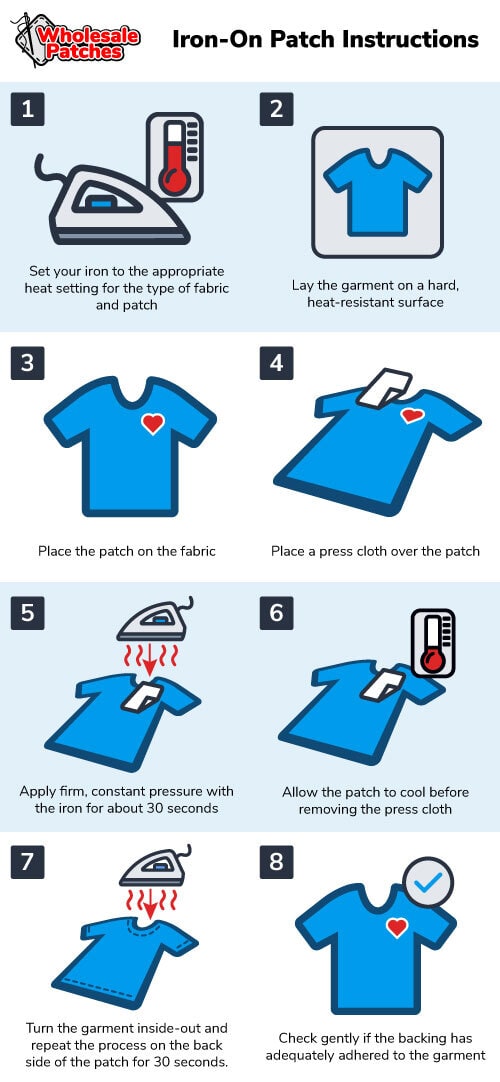Custom Iron On Patches
Iron-on patches have become increasingly popular in recent years as a way to personalize and add a unique touch to clothing, bags, and other accessories. These patches, also known as heat-seal patches, can be easily applied to fabric by using heat from an iron or heat press. It is important to note that iron-on patches are not a specific type or style of patch but an option available as a backing for various patch types. Let's explore the benefits and uses of iron-on patches, as well as tips for applying and maintaining them.

Types of Iron-On Patches
There are several types of iron-on patches to choose from, each with its own unique characteristics. The most common types include:
-
Embroidered patches : These patches are made using a combination of thread and fabric and are often used for club and organization logos, military patches, and more.
-
Printed patches : These patches are made using a printing process and can feature a wide range of designs and colors. They are often used for promotional and advertising purposes.
-
Woven patches : These patches are made using a weaving process and can be very detailed and precise. They are often used for high-end fashion and luxury items.
-
Name patches : These are patches with a person's name on it. They are often used in uniforms, bags, and other items that need identification.
Unlike their fabric counterparts, PVC Patches and Leather Patches cannot be affixed using heat as this would cause damage to the material. Instead, alternative methods such as sewing, Velcro backing, or specialized adhesives are used to secure them to the desired surface.
Iron-On Patch Instructions: A Step-by-Step Guide
Applying iron-on patches is a simple process that can be done at home with a household iron or heat press. This guide will walk you through the process of applying iron-on patches, from selecting the right patches to properly caring for your finished product.
Preparing the Fabric
Before applying the patch, it's important to prepare the fabric by washing and ironing it. This will remove any dirt or wrinkles and ensure that the patch adheres properly. It is important to note that the heat-seal or iron-on backing is most effective when used on natural fabrics like cotton or denim and may not provide a strong adhesion on synthetic fabrics like nylon or stretch fabrics.
Placing Your Patch
When applying your iron-on patch, place it face-up in your desired location. If you're unsure where to place it, here are a few suggestions:
-
Shirts : A popular spot is 7-9 inches down from the left shoulder seam, between the center and side seam, or 4-6 inches to the right of center. Avoid placing it below the armpit.
-
Jackets , pants , and shorts : Consider clustering multiple patches in one area or ironing on numerous patches in a trail down the sleeves or legs. The possibilities are endless!
-
Bags : Any place is as good as any. Go wild! Just be mindful of any seams, zippers, handles, or straps on the bag.
-
Hats : Front and center is a popular choice location, about half an inch from the bottom. Be sure to check the measurements of your patch to ensure it's no more than 5 inches wide by 2.5 inches high. 2 inches by 2 inches are generally perfect for the front, back, or sides of hats.
Applying the Patch

-
Set your iron to the appropriate heat setting for the type of fabric and patch you are using. We generally recommend medium-high heat, but this might vary based on your fabric material and the kind of patch you are applying.
-
Lay the garment on a hard, heat-resistant surface when applying your iron-on patch. Avoid using a padded ironing board as it may not provide strong adhesion. Instead, consider using a wooden cutting board or a stone counter-top as an alternative.
-
Place the patch on the fabric, making sure it is positioned correctly.
-
Place a piece of parchment paper or a press cloth will work just as well.
-
Apply firm, constant pressure straight down with the iron for about 30 to 35 seconds without moving the iron.
-
Allow the patch to cool for a little before removing the protective sheet.
-
Turn the garment inside-out and repeat the process on the back side of the patch for about 30 seconds. Be sure and apply constant pressure once again.
-
After applying heat to the patch, check gently if the backing has adequately adhered to the garment. Allow the patch to cool down completely before handling it further. This will help to ensure that the heat-seal backing is securely attached to your garment. If necessary, repeat steps 4-7 to ensure proper adhesion.
Caring for Your Patched Item
Once the patch is applied, it's important to properly care for the item to ensure that the patch lasts as long as possible.
-
Wait for 48 hrs before washing the garment to ensure the heat seal is fully set. Hand-washing is recommended.
-
To protect your patch and your garment, turn it inside-out when washing.
-
Avoid washing the item in hot water or putting it in the dryer.
-
If needed, iron the patched area on a low heat setting, and always use a press cloth.
-
Sew on your patch for a more permanent installation.
Iron-on patches are a quick and easy way to add a personal touch to clothing and other fabric items. By following these simple steps, you can ensure that your patches look great and last for a long time.